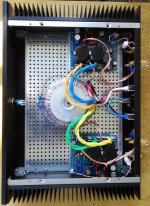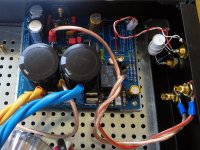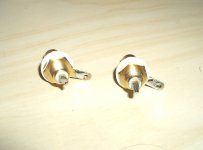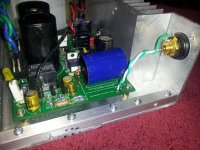Whew! I gave both boards another thorough cleaning and now they're working perfectly! 😎
Good! 🙂
I tried grounding the shielding of one channel's hook-up cables and that shut it up completely, so I think in the final amp I'll be fine as long as I use shielded cables throughout.
Maybe you could try to tie togheter shield and signal ground at the RCA socket, using shielded cabling shouldn't be necessary (doesn't hurt though)
I should also mention that the amp sounds absolutely fabulous!
🙂
Grounding problem?
Dear All,
I have finally assembled the MyRef FE.
At first I had a loud buzz when amp inputs were disconnected. Then I connected the PGND of both channels to the chassis in one point (without the ground lift, just the wire) and buzz disappeared. Now the amp has a slight hum when not connected to anything, but is almost inaudible when inputs are shorted. All as it shall be.
Situation changes when I connect something to it. If I hook it up to a desktop computer output or even a battery powered laptop or tablet, the amp becomes unpleasantly noisy. I checked if anything changes when I disconnect one channel but situation is the same - the connected channel is noisy.
Could someone suggest what kind of grounding problem can it be and a possible solution?
Oleg
Dear All,
I have finally assembled the MyRef FE.
At first I had a loud buzz when amp inputs were disconnected. Then I connected the PGND of both channels to the chassis in one point (without the ground lift, just the wire) and buzz disappeared. Now the amp has a slight hum when not connected to anything, but is almost inaudible when inputs are shorted. All as it shall be.
Situation changes when I connect something to it. If I hook it up to a desktop computer output or even a battery powered laptop or tablet, the amp becomes unpleasantly noisy. I checked if anything changes when I disconnect one channel but situation is the same - the connected channel is noisy.
Could someone suggest what kind of grounding problem can it be and a possible solution?
Oleg
Hi Oleg
With inputs disconnected hum is normal with the My_Ref.
It's not necessary to ground PGND, in fact the amp usually sounds better with PGND disconnected.
With input shorted it should be deadly silent, unless you have very sensitive loudspeakers.
In such case try to ground heatsinks, the remaining (faint) hum should disappear.
Really strange... are you sure signal and signal ground are not swapped?
At first I had a loud buzz when amp inputs were disconnected. Then I connected the PGND of both channels to the chassis in one point (without the ground lift, just the wire) and buzz disappeared.
With inputs disconnected hum is normal with the My_Ref.
It's not necessary to ground PGND, in fact the amp usually sounds better with PGND disconnected.
Now the amp has a slight hum when not connected to anything, but is almost inaudible when inputs are shorted. All as it shall be.
With input shorted it should be deadly silent, unless you have very sensitive loudspeakers.
In such case try to ground heatsinks, the remaining (faint) hum should disappear.
Situation changes when I connect something to it. If I hook it up to a desktop computer output or even a battery powered laptop or tablet, the amp becomes unpleasantly noisy.
Really strange... are you sure signal and signal ground are not swapped?
Hi Dario,
Thanks a lot for quick reply. It does sound strange to me as well. To make things more clear I attached the pictures of an assembled amp.
Please let me know if you see something obvious (or not so obvious).
I am currently out of ideas.
Oleg
Thanks a lot for quick reply. It does sound strange to me as well. To make things more clear I attached the pictures of an assembled amp.
Please let me know if you see something obvious (or not so obvious).
I am currently out of ideas.
Oleg
Attachments
Hi,
I am sure that Dario is the expert and will see something else, but here are the things that I notice different from my build.
1. You have PGND connected to the chassis. Try removing it from the faston on the board and see if the noise improves.
2. It is hard to see in the picture. Are the RCA inputs isolated from the chassis? If the negative side of the signal is connected to the chassis, then it would be possible to have a ground loop through PGND, the chassis, the RCA negative, and the amp.
3. What is going on at the input? It looks like you have a signal RCA connected in the normal way, connected through a capacitor to another RCA, a resistor between the 2nd RCA signal and negative, and a "coil" between the negative of the two RCAs. In addition, you have a jumper C13 on the board. In my amp, I have C13 at the board connections and the signal directly from an isolated RCA. Can you explain the extra parts at input?
Jac
I am sure that Dario is the expert and will see something else, but here are the things that I notice different from my build.
1. You have PGND connected to the chassis. Try removing it from the faston on the board and see if the noise improves.
2. It is hard to see in the picture. Are the RCA inputs isolated from the chassis? If the negative side of the signal is connected to the chassis, then it would be possible to have a ground loop through PGND, the chassis, the RCA negative, and the amp.
3. What is going on at the input? It looks like you have a signal RCA connected in the normal way, connected through a capacitor to another RCA, a resistor between the 2nd RCA signal and negative, and a "coil" between the negative of the two RCAs. In addition, you have a jumper C13 on the board. In my amp, I have C13 at the board connections and the signal directly from an isolated RCA. Can you explain the extra parts at input?
Jac
Thanks for reply Jac!
1. The PGND is connected to the chassis because it helps to remove the loud buzz which I have otherwise. It has no influence on the noise/hum.
2. RCAs are isolated from the chassis.
3. The input of the amp has two RCAs per channel: before and after the input cap (C13), which is soldered between the RCAs center connectors (AC and DC coupled inputs, respectively), hence the jumper on the board. The "coil" is probably the signal reference wire wrapped around the input cap. May be not the best way of doing it "coaxial" with the signal path through the cap. The 1.5 MOhm resistor across the bottom RCA is there to make an RF filter together with the input cap if the upper DC coupled RCA input is used (suggested by AndrewT). I hope I did it right.
Today I tried to connect an iPod Nano to the amp and it is dead silent, only music and no noise. May be my problem is the high input impedance of the amp and noisy sources that I have? I have an old parallel LM4780 amp from chipamp.com and it has a bit of noise with same sources as well but much less, on an acceptable level. It also has around 5 times lower input impedance if I remember correctly.
1. The PGND is connected to the chassis because it helps to remove the loud buzz which I have otherwise. It has no influence on the noise/hum.
2. RCAs are isolated from the chassis.
3. The input of the amp has two RCAs per channel: before and after the input cap (C13), which is soldered between the RCAs center connectors (AC and DC coupled inputs, respectively), hence the jumper on the board. The "coil" is probably the signal reference wire wrapped around the input cap. May be not the best way of doing it "coaxial" with the signal path through the cap. The 1.5 MOhm resistor across the bottom RCA is there to make an RF filter together with the input cap if the upper DC coupled RCA input is used (suggested by AndrewT). I hope I did it right.
Today I tried to connect an iPod Nano to the amp and it is dead silent, only music and no noise. May be my problem is the high input impedance of the amp and noisy sources that I have? I have an old parallel LM4780 amp from chipamp.com and it has a bit of noise with same sources as well but much less, on an acceptable level. It also has around 5 times lower input impedance if I remember correctly.
OlegSH, at any time did you have the input wired in the "traditional" way as Jac described, and if so did you still have hum and/or noise problems?
Thanks a lot for quick reply. It does sound strange to me as well. To make things more clear I attached the pictures of an assembled amp.
You're welcome, Oleg.
I would second Bob's suggestion:
OlegSH, at any time did you have the input wired in the "traditional" way as Jac described, and if so did you still have hum and/or noise problems?
The kind of RCAs you used seems similar to the ones I've used in my Gainclone.
I've somewhat overheated them soldering and while they looked perfect I've had a hum that has been fixed only with a new pair of RCAs.
Also, since you have problems, it's a wise idea, IMHO, to start from a simpler input approach.
BTW what is the resistor role?
This seems odd. Can you explain what tests you have done?.......................1. The PGND is connected to the chassis because it helps to remove the loud buzz which I have otherwise. It has no influence on the noise/hum.
Isolated RCAs OK.2. RCAs are isolated from the chassis.
3. The input of the amp has two RCAs per channel: before and after the input cap (C13), which is soldered between the RCAs center connectors (AC and DC coupled inputs, respectively), hence the jumper on the board. The "coil" is probably the signal reference wire wrapped around the input cap. May be not the best way of doing it "coaxial" with the signal path through the cap. The 1.5 MOhm resistor across the bottom RCA is there to make an RF filter together with the input cap if the upper DC coupled RCA input is used (suggested by AndrewT). I hope I did it right.................
The 1M5 is not RF attenuation. It is to source capacitor leakage to Signal Ground.
If you want additional RF attenuation at the RCAs, then add a 22pF to 47pF across the Hot to Return of the RCAs.
You should also have RF attenuation on the amp PCB.
Dual inputs, one for DC and one for AC gives operational flexibility. Use whichever DC blocking cap is better.
I like the attempts to reduce LOOP AREA.
But you have left Big Loops at the RCAs.
The solder tags are many mm away from Hot. This creates excessive Loop Area.
I'll try to explain my observations.
If inputs are disconnected I have clear mains frequency buzz. This I managed to solve by connecting PGND to chassis.
With PGND connected to chassis the amp has a tiny hum when not connected to anything. If input is shorted the amp is dead quiet. This as I've read before in this thread (and Dario mentioned this again recently) is a normal situation.
Then I tried different sources and discovered that they are all noisy except the iPod Nano. This one works perfectly without the noise or hum.
The outputs of my desktop computer, laptop or even a tablet (two last ones were running on a battery at the time of tests) are so noisy that I can't use them with the amp. I tried to use the Blu-Ray player as the source and that was noisy too. In most cases the noise sounds like it is of digital origin. On the computer output I also hear the cpu fan through the speakers, on tablet and laptop almost every move of a pointer, opening or closing the apps is audible via noise.
I tend to believe that my problem are the noisy sources rather than the amp.
I tried same experiments with my LM4780 and it shows same symptoms but significantly less audible probably due to much lower input impedance.
So far the only trouble free source for the amp is the iPod Nano. And I have no other source to try.
PS: I understand the concern about the loop area near the RCA sockets. I'll probably later re-solder the signal ground wire to the edge of RCA socket near the center pin.
If inputs are disconnected I have clear mains frequency buzz. This I managed to solve by connecting PGND to chassis.
With PGND connected to chassis the amp has a tiny hum when not connected to anything. If input is shorted the amp is dead quiet. This as I've read before in this thread (and Dario mentioned this again recently) is a normal situation.
Then I tried different sources and discovered that they are all noisy except the iPod Nano. This one works perfectly without the noise or hum.
The outputs of my desktop computer, laptop or even a tablet (two last ones were running on a battery at the time of tests) are so noisy that I can't use them with the amp. I tried to use the Blu-Ray player as the source and that was noisy too. In most cases the noise sounds like it is of digital origin. On the computer output I also hear the cpu fan through the speakers, on tablet and laptop almost every move of a pointer, opening or closing the apps is audible via noise.
I tend to believe that my problem are the noisy sources rather than the amp.
I tried same experiments with my LM4780 and it shows same symptoms but significantly less audible probably due to much lower input impedance.
So far the only trouble free source for the amp is the iPod Nano. And I have no other source to try.
PS: I understand the concern about the loop area near the RCA sockets. I'll probably later re-solder the signal ground wire to the edge of RCA socket near the center pin.
Then I tried different sources and discovered that they are all noisy except the iPod Nano. This one works perfectly without the noise or hum.
(...)
I tried to use the Blu-Ray player as the source and that was noisy too. In most cases the noise sounds like it is of digital origin. On the computer output I also hear the cpu fan through the speakers, on tablet and laptop almost every move of a pointer, opening or closing the apps is audible via noise.
I tend to believe that my problem are the noisy sources rather than the amp.
The Blue-Ray player can't be noisy... with my defective RCAs I was able to hear through the amp switching the light on/off and when the refrigerator's compressor kicked it.
Replaced the RCAs, problem fixed.
Don't you have a pair of cheap but new RCAs to try?
I just don't understand what can be damaged inside of the RCA socket!? I have two RCA inputs per channel, all 4 sockets have same symptoms. I still have a set of new RCAs but they are the same brand as the ones I used for the amp. I can give them a try but I still doubt it will solve my problem. May be I can try another brand assuming that all my RCAs are defective.
But anyways, why it works with iPod? The signal cable is the same in all cases, so bad contact in the RCA socket is hard to believe.
But anyways, why it works with iPod? The signal cable is the same in all cases, so bad contact in the RCA socket is hard to believe.
I'm not sure the RCAs are the source of your problem but the way you're describing it remember mine, take a read:
http://www.diyaudio.com/forums/chip-amps/135170-strange-buzz-only-one-channel.html
If you try, at least, you can exclude one possible source.
The defective RCAs:

http://www.diyaudio.com/forums/chip-amps/135170-strange-buzz-only-one-channel.html
If you try, at least, you can exclude one possible source.
The defective RCAs:
Attachments
Last edited:
I just don't understand what can be damaged inside of the RCA socket!?
But anyways, why it works with iPod? The signal cable is the same in all cases, so bad contact in the RCA socket is hard to believe.
Nobody wants to do it, but getting back to the basic configuration is very important in trouble shooting. Your extras at the inputs can easily act as antennas that can collect airborne interference. A simple short twisted pair from the RCA to the board helps block that. (see pic)
Being a bit repetitive - for clarity - the amps WILL be noisy with nothing attached to the input. If your Blu-Ray player has RCA outs (line level) that noise should stop if you use RCA interconnects and a volume pot. It sounds like you have used a mini-phono plug (1/8") on all your tests???
A good way to confirm the RCAs would be to use your extras with a short twisted pair and just bypass what you have on the chassis. Just let the RCA float without touching the chassis. Install the input cap back on the board when you try this. I know - it sounds like you are going backwards, but it may be necessary.
Attachments
This is clearly wrong.I'll try to explain my observations.
If inputs are disconnected I have clear mains frequency buzz............
It requires a CHANGE in existing wiring. It does not need an EXTRA connection which may be ADDING another LOOP.
I tried to remove the input connector from the amp board and with the PGND disconnected from the chassis (basically the amp is totally insulated then) I have mains frequency buzz. If PGND is connected to the chassis the amp behaves "normally" until I attach a source to it.
Having a toroidal transformer makes me wonder where the buzz problem can come from. I have also connected the inter winding screen of the transformer to the chassis at the safety ground bolt right next to the transformer. May be I should consider screening the mains inlet with all the excessive cabling/switching that I have in order to eliminate the buzz!?
Also twisting of cables is a bit difficult due to larger than necessary insulation tubing on the transformer leads. May be I should strip it out and twist tightly the leads first!?
Having a toroidal transformer makes me wonder where the buzz problem can come from. I have also connected the inter winding screen of the transformer to the chassis at the safety ground bolt right next to the transformer. May be I should consider screening the mains inlet with all the excessive cabling/switching that I have in order to eliminate the buzz!?
Also twisting of cables is a bit difficult due to larger than necessary insulation tubing on the transformer leads. May be I should strip it out and twist tightly the leads first!?
The buzz, when no Chassis, indicates a wiring error.I tried to remove the input connector from the amp board and with the PGND disconnected from the chassis (basically the amp is totally insulated then) I have mains frequency buzz. If PGND is connected to the chassis the amp behaves "normally" until I attach a source to it.
Having a toroidal transformer makes me wonder where the buzz problem can come from. I have also connected the inter winding screen of the transformer to the chassis at the safety ground bolt right next to the transformer. May be I should consider screening the mains inlet with all the excessive cabling/switching that I have in order to eliminate the buzz!?
Also twisting of cables is a bit difficult due to larger than necessary insulation tubing on the transformer leads. May be I should strip it out and twist tightly the leads first!?
I'm not sure it will work for you, but several builders have found that grounding the transformer screen added hum. The MyRef design is a little unusual in it's grounding scheme. The configuration that has been quiet for me is;
- transformer ungrounded
- PGND not connected
- Single RCA isolated from the chassis ( this means that ground is only through the signal minus to the signal source )
- C13 as a capacitor in the signal stream for DC blocking
When a GND is connected to the house ground by another path than signal minus, it forms a ground loop through R11 which can cause noise. This is not a mistake, but a feature of this kind of amplifier where the speaker's impedance is part of the feedback. It does mean that it is sensitive to how it is grounded regarding noise.
- transformer ungrounded
- PGND not connected
- Single RCA isolated from the chassis ( this means that ground is only through the signal minus to the signal source )
- C13 as a capacitor in the signal stream for DC blocking
When a GND is connected to the house ground by another path than signal minus, it forms a ground loop through R11 which can cause noise. This is not a mistake, but a feature of this kind of amplifier where the speaker's impedance is part of the feedback. It does mean that it is sensitive to how it is grounded regarding noise.
- Home
- Amplifiers
- Chip Amps
- My_Ref Fremen Edition - Build thread and tutorial




